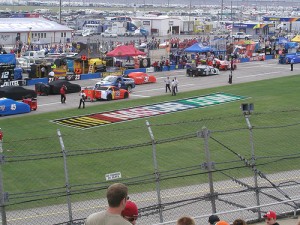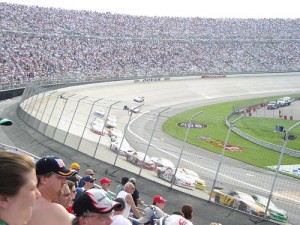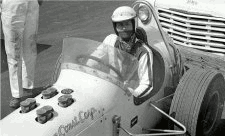Some Thoughts on Spectator Safety
ByAfter Carl Edwards' crash last week, there has been a lot of scrutiny focused on racing at Talladega Superspeedway, and in particular the track itself. Some in the media have even called to have the track bulldozed and rebuilt at a smaller size or with little banking. And something has to be done "fast" before spectators are killed, which would undoubtedly doom auto racing in America.
But let's step back, take a deep breath, and make sure that we examine the situation fairly and with a broader approach. We need a solution that's going to work everywhere, not just Talladega.
Talladega: 3 for 3
The good news is that of the three times that section of fence has been tested at Talladega, each time it has held up well and done its job. And this time was the first that the fence wasn't compromised. (Watch Bobby Allison tear down a large section of fence in 1987 and then Neil Bonnett put a hole in the fence in 1993.)

The fence at Talladega is supported by heavy cables. Click to see a larger view of the picture. (Photo by flickr.com user dhall / Creative Commons 2.0.)
After Jimmy Horton left the speedway in 1993, International Speedway Corp. lined all of their large tracks with cabled fences to keep cars from going over the wall. Along the front stretch grandstand area, this meant placing the cable fence in front of the previous chain-link debris fence.
Critics are claiming that Talladega is too dangerous of a place to race, and that NASCAR is irresponsible for racing there. And it is true that Talladega is dangerous... all motorsports are, and that is precisely part of the attraction. As Paul Page once said, "Without that risk, the men are just ordinary." Like it or not, we spectators participate in that risk and are drawn to it.
But there really is no reason to castrate a place like Talladega with limp-wristed solutions that permanently alter the very nature of the track. If safety is our only priority, why not just institute a 25 mph speed limit? Guaranteed no injuries... and no interest.
It Could Happen Anywhere
Because of the high speeds, it's easy to point the fingers at Talladega and Daytona as the tracks most likely to produce a disaster. But the cars go just as fast at Pocono, Indianapolis, Michigan, Atlanta, etc., albeit not for sustained speeds.
Some argue that cars are less likely to get airborne at the other tracks. And that's true... but it's still possible, and all you need is one incident. After all the incidents at Talladega in July 1993, I remember Benny Parsons saying that the only thing that could be done is leveling the banks and making a flatter track like that at Michigan, where the drivers have to let out of the gas through the turns. Only a couple weeks later when the tour moved to that very same track, Johnny Benson got turned sideways and his V6-car went airborne and flipped several times down the backstretch.
Even in the era of roof flaps it's possible: In 2000 Elliott Sadler blew a tire and went flying through turn 1, also at Michigan.
Many Ways to Get Airborne
At Talladega and Daytona we often see cars get airborne just from the "inverted wing" that occurs when they get backwards or sideways, but of course there are many ways to get a car into the air high enough to hit the catch fence. A quick turn to the right could easily roll a car over. (Watch Dave Blaney get turned and how in a split-second he flips over and heads into the wall.) Or, a car can launch over the front of another and get high in the air, like Geoff Bodine's did at Daytona in 2000.

Does anybody seriously think this fence at Dover would hold up to a head-on impact from a 3500lb car traveling at 150mph? The fence didn't have an overhang until the late 1990s. (Photo by flickr.com user davidpb145 / Creative Commons 2.0.)
These types of crashes could happen anywhere. How well would other fences on the circuit hold up against direct, head-on impacts?
Don't Forget About Indy Cars
It's easy to pick on NASCAR, but I've long been concerned about an Indy car outright flying over one of these fences. The cars go so fast and are so light, and with the weight being in the rear of the cars it doesn't take much to get one to lift off from the front (by, for example, making wheel-to-wheel contact or even running over a piece of debris). Remember when Mario Andretti ran over some debris during practice at Indianapolis in 2003? His car went flying so high that it hit the very top of the fencing before coming back down. Imagine going into turn one at Indy and getting airborne that high just as the track angle turns.
Or consider Tony Renna's crash during tire testing at Indy in October 2003. Renna lost control exiting turn 3 -- one of the slowest parts of the track -- got backwards, went airborne and reportedly tore down 50 feet of fencing. Renna was fatally injured and although the tub of the car didn't make it through the fence, apparently a not insignificant portion of the car did. There is some controversy over exactly what happened, but nevertheless helicopter photos taken after the incident show that at least the railing of the concourse walkway was damaged. A concourse that could have been packed on race day.
The Best Solution
The best response to the Carl Edwards crash is to raise the fences at Talladega and Daytona by at least 5 feet, add a longer overhang, and add more cables to match the new height. Other race tracks should invest in the thicker cables as well. Perhaps a diagonal or hatched pattern for the cables would be more effective than the oft-employed horizontal style. (Though at some point you have to balance visibility with safety.)
The downside to the newer, stronger catch fences that have become more commonplace is that they absolutely shred Indy cars to pieces. (Watch Kenny Brack at Texas and Ryan Briscoe at Chicagoland.) But I lay that problem more on the cars than the fence.
Don't Forget About the Infield!
Some tracks that have infield spectators should probably ensure they're protected by a solid fence at well. Tracks like Pocono and Michigan... it wouldn't be difficult to get a car airborne and headed towards an inside fence.
Ohh yeah... it could happen at your local short track too!

